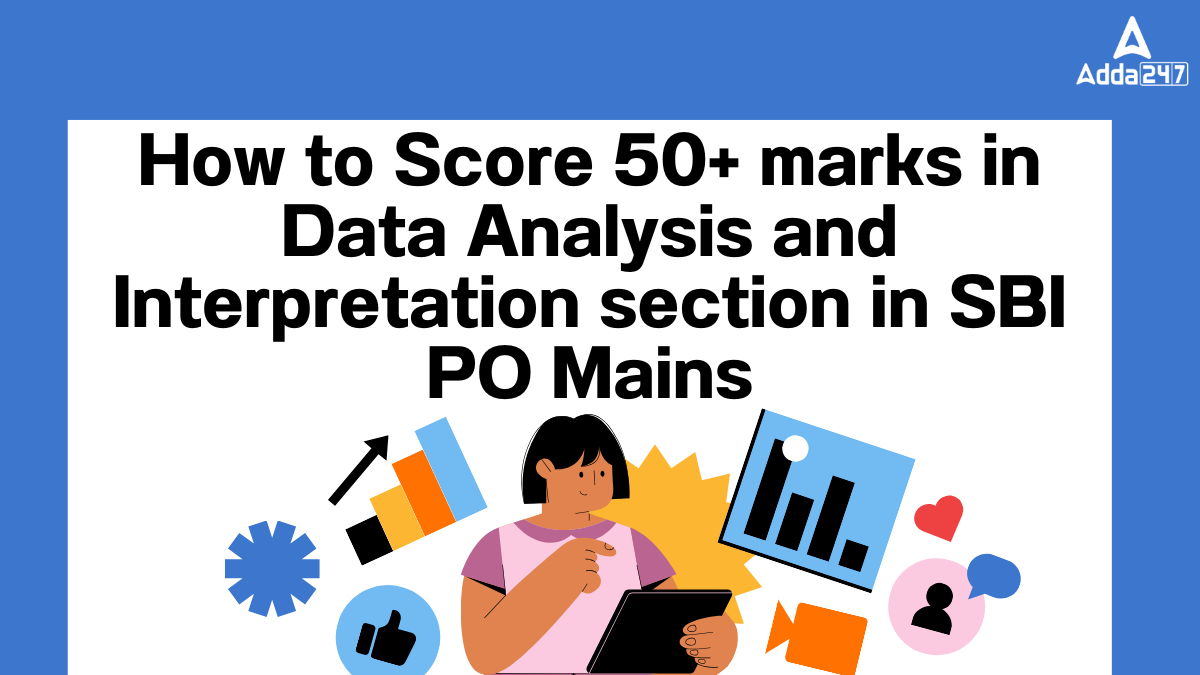Table of Contents
The Data Analysis and Interpretation section in the SBI PO Mains 2025 Exam is a crucial section, consisting of 30 questions for 60 marks, with a time limit of 45 minutes. This section tests candidates on their analytical ability, problem-solving skills, and numerical aptitude. To secure 50+ marks, candidates need a structured approach, including conceptual clarity, strategic time management, rigorous practice, and smart calculation techniques. In this column, we will cover effective strategies, important topics and expert tips to help candidates maximize their scores in this section.
Data Analysis and Interpretation section in SBI PO Mains 2025
Scoring 50+ marks in the Data Analysis and Interpretation section of the SBI PO Mains 2025 Exam is achievable with the right strategy, focused practice, and time management. Mastering DI sets, arithmetic-based problems, data sufficiency, and shortcut techniques can significantly boost your score. Regular mock tests, previous year paper analysis, and concept clarity are essential to maximizing performance.
The difficulty level of this section is moderate to difficult, and it primarily includes Data Interpretation (DI), Arithmetic-Based Problems, and Data Sufficiency.
Important Topics to Focus in Data Analysis and Interpretation of SBI PO
To score 50+ marks, candidates should prioritize high-scoring topics and practice them extensively. The major topics in this section include:
1. Data Interpretation (DI)
Types: Tabular DI, Pie Charts, Bar Graphs, Line Graphs, Radar Charts, and Caselet DI.
Tip: Practice at least 5 sets of DI questions daily and focus on mixed DI sets that require advanced calculations.
2. Arithmetic-Based DI
Topics Covered: Percentage, Ratio & Proportion, Average, Profit & Loss, Time & Work, Mixture & Allegations, and Simple & Compound Interest.
Tip: Strengthen basic arithmetic concepts as these are directly applied in DI questions.
3. Data Sufficiency
Types: 2-Statement and 3-Statement Data Sufficiency Problems.
Tip: Improve logical reasoning skills to quickly determine whether the given data is sufficient to answer the question.
4. Caselet DI
Types: Paragraph-Based Data Interpretation without direct numerical representation.
Tip: Improve reading speed and comprehension skills to quickly extract relevant numerical information.
5. Probability and Permutation & Combination
Topics: Basic Probability, Arrangements, Selection, and Distribution-Based Problems.
Tip: Learn shortcut tricks and formulas to solve probability-based DI questions efficiently.
Strategies to Score 50+ marks in Data Analysis and Interpretation section in SBI PO Mains 2025 exam
1. Strengthen Your Basics: Before solving complex DI sets, ensure your fundamentals in percentages, ratios, averages, and speed calculation techniques are strong. Without conceptual clarity, solving high-level DI questions becomes challenging.
2. Focus on Speed and Accuracy
Develop a mental calculation habit to avoid excessive dependency on calculators.
Use Vedic Maths techniques for faster multiplication, division, and percentage calculations.
Maintain an accuracy rate of 85-90% to minimize negative marking.
3. Prioritize High-Weightage Questions
In the first 15-20 minutes, solve easy DI sets and arithmetic questions to secure 30+ marks quickly.
Avoid time-consuming questions initially; mark them for later if time permits.
4. Attempt Mock Tests and Sectional Tests
Solve two full-length mock tests per week to assess your strengths and weaknesses.
Take topic-wise sectional tests to focus on weak areas.
Analyze your mistakes and re-attempt incorrect questions for better understanding.
5. Learn Smart Approximation and Elimination Techniques
Use approximation techniques for ratio and percentage-based calculations to save time.
When solving data sufficiency questions, use the elimination method to quickly determine the sufficiency of given data.
6. Time Management Strategy
Divide your 45 minutes wisely:
First 15 minutes: Attempt easy DI sets and arithmetic-based problems.
Next 20 minutes: Focus on moderate-level caselet DI and data sufficiency questions.
Last 10 minutes: Solve high-level DI sets and revisit marked questions.
7. Use Shortcut Formulas for Quick Calculations
Memorize important formulas such as:
- Percentage to Fraction Conversion (e.g., 12.5% = 1/8, 16.67% = 1/6)
- Average Speed Formula: (2xy) / (x + y)
- Compound Interest Formula
Final Tips to Ace the SBI PO Exam
Develop a Study Plan: Dedicate at least 2-3 hours daily to Data Interpretation practice.
Utilize Previous Year Paper: SBI PO Mains Previous Year Papers to understand the difficulty level and frequently asked questions.
Give Mock Test: Online Mock Tests to practice time management.
Solev DI Quizzes: Daily DI Quizzes from online platforms (like Adda247) to keep improving problem-solving speed.
Avoid Guesswork: Focus on solving with accuracy rather than making blind guesses.
Stay Confident and Consistent: Regular practice is the key to improving speed and accuracy.
Stay Updated: Follow current banking and economic trends, as some DI sets may be related to financial data.




 GA Capsule for SBI Clerk Mains 2025, Dow...
GA Capsule for SBI Clerk Mains 2025, Dow...
 The Hindu Review October 2022: Download ...
The Hindu Review October 2022: Download ...
 AAI ATC Syllabus 2025 and Exam Pattern
AAI ATC Syllabus 2025 and Exam Pattern


